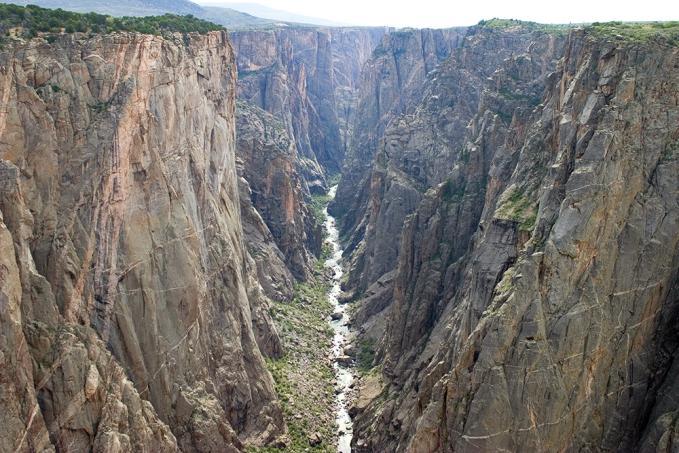Getting To Black Canyon Of The Gunnison National Park
- By Rebecca Latson - January 5th, 2025 12:04pm

Chasm view, Black Canyon of the Gunnison National Park / NPS-Lisa Lynch
Uplift, volcanism, water, erosion, and time have all played their parts to create what the National Park Service calls “some of the steepest cliffs, oldest rock, and craggiest spires in North America.” Black Canyon of the Gunnison National Park in Colorado will introduce you to one of the best examples in the world of exposed 1.8 billion-year-old metamorphic basement rock.
The total canyon length is 48 miles (77 km), 14 miles (22.5 km) of which runs through the national park. It’s not the largest park unit within the National Park System, but there is plenty for visitors to see and do, including hiking, rock climbing, scenic driving, fishing, horseback riding, rafting and kayaking, and wildlife watching. During the winter, there’s cross-country skiing and snowshoeing, including ranger-guided snowshoeing.
Humans have roamed along and inhabited the canyon’s rim for 9,000 years. Five federally-recognized tribes and one tribal community claim traditional and cultural ties to the area. Spaniards were the first Europeans who became aware of the Black Canyon of the Gunnison as they searched for passage to the California coast. Fur trappers, prospectors looking for mineral wealth, and expeditions searching for water resources as well as potential railway passages all traveled along the canyon rim. Interest in the area’s beauty and recreational opportunities brought people to marvel at the landscape beyond the canyon’s edge.
Designated a national monument in 1933, the federal government brought in the Civilian Conservation Corps (CCC) to build trails, roads, campgrounds, and NPS buildings. Mission 66 projects completed during the 1960s also brought new life to the roads, scenic overlooks, and campgrounds. Redesignated a national park in October 1999, Black Canyon of the Gunnison covers 30,750 acres (12,444 hectares) of steep cliffs, pinyon pine, juniper, and scrub oak forests, and a riparian environment along the Gunnison River. For the past five years, almost half a million visitors have marveled at the scenic canyon vistas this national park offers, located less than 50 miles (80.5 km) away from Curecanti National Recreation Area and its different perspective of the Gunnison River.
Although there is no in-park lodging, Black Canyon of the Gunnison National Park is located one hour’s drive southeast of Grand Junction, Colorado, and 20 minutes east-northeast of Montrose, Colorado, both towns offering brick-and-mortar options for overnighting near the park. If you feel like pitching a tent beneath the clear night sky, there are two campgrounds – one on the north rim and one on the south rim – as well as a campground right next door at Curecanti National Recreation Area which is accessed via the national park.
Depending upon the season and whether you are visiting the canyon rim at 8,000 feet/2,438.4 km or canyon floor at 6,000 feet/1,828.8 m, you can expect a wide variation in weather and temperature. It’s a good idea to pack clothing layers.
According to park staff:
Spring and Fall
Daytime temperatures are mild from 40°F to 70°F (4°C to 34°C) with overnight lows from the teens to about freezing (-9°C to 2°C). Snow is common in early spring and late fall.
Summer
Summer daytime temperatures range between 60°F to 100°F (15°C to 38°C) and nights range from 30°F to 50°F (-1°C to 10°C). Brief afternoon thunderstorms can occur during the summer.
Winter
Winter daytime temperatures range between 20°F to 40°F (-6°C to 4°C) and overnight temperatures range from -10° to 20°F (-23°C to -6°C). Snow is common in the winter months.
Visit www.COtrip.org for information about road conditions in Colorado.
Whether you are just passing through or planning to stay a day or more, the pages below will help you plan your trip.
Traveler’s Choice For: geology, scenic driving, photography


National Parks Traveler is a 501(c) (3) nonprofit.


Here’s the definitive guide to National Park System campgrounds where RVers can park their rigs.
Our app is packed with RVing- specific details on more than 250 campgrounds in more than 70 national parks.
You’ll also find stories about RVing in the parks, tips helpful if you’ve just recently become an RVer, and useful planning suggestions.
